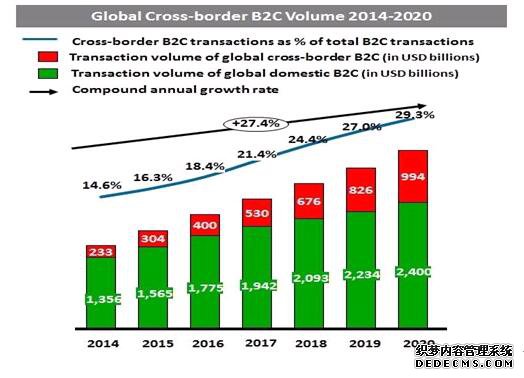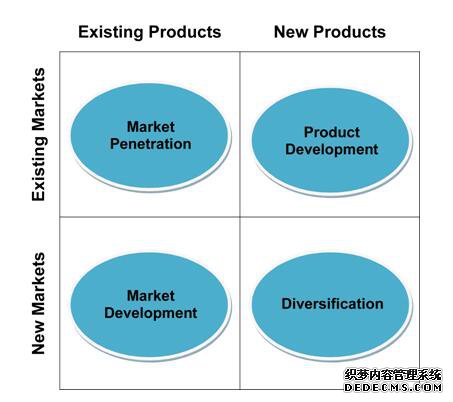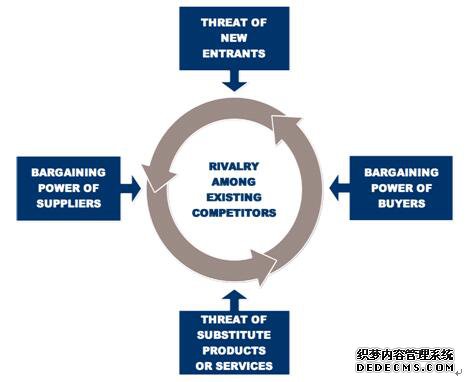|
Ladies and Gentlemen, Good afternoon! 女士们先生们,下午好!
我很高兴站在这里给你作简短的演讲。今天,我的主题是如何开展中小企业基于互联网的外国市场渗透研究——以2010-2016年贾胜服装为例(在黑板上写下该主题)。希望你会喜欢。
首先,我要问你一个问题,随着互联网时代和全球一体化的到来,全球跨境B2C交易量迅速增长(如图1所示),在这个过程中,许多公司都通过国际化取得了成功,这是一个更可能实现的大企业或中小型企业。国际化成功?传统上,人们认为大型企业更有可能成功,因为他们有更多的资源。然而,事实上,许多中小企业在成立之初就实现了国际化(Odlin和Benson Rea,2017)。为什么?它们在资源、人才、财力等方面远不及大型企业,因此,自20世纪90年代以来,它们在国际上取得成功的原因引起了许多学者的关注(Mosberger,2011年)。进入2010年,学者们发现,除了传统的市场准入、资源准入、竞争优势准入等模式外,中小企业都是通过互联网实现国际化,这种模式越来越普遍。我的目的是研究中小型服装企业如何以贾生为例,通过互联网实现国际化。
杭州嘉盛服装有限公司(简称嘉盛)成立于2008年。公司现有员工约200人,年收入达8000万美元。2009年,该公司开始利用阿里巴巴与美国的服装公司合作。由于其提供的产品具有优良的服装质量、低廉的价格、及时的交货期,使其国际合作伙伴满意,在其成立初期就实现了国际化的成功。然而,自2010年以来,由于国内劳动力成本快速上涨,利润大幅下降,公司不得不考虑改变低价模式。
I’m very glad to stand here and give you a short speech. Today my topic is about how I will carry out study on Internet-based foreign market penetration by SMEs- a cases tudy of Jia Sheng Garment during 2010-2016 (write down the topic on the blackboard). I hope you will like it.
First of all, I will ask you a question, as the era of the Internet and the global integration comes, the global cross-border B2C volume increased rapidly (as shown in Figure 1), in this process, many companies have succeed through internationalization, it is a large enterprise or a small and medium-sized enterprise which is more likely to achieve internationalization successfully? Traditionally, it is believed that large enterprises are more likely to succeed as they have more sources. However, in reality, many small and medium-sized enterprises have achieved internationalization at the beginning of their establishment (Odlin and Benson-Rea, 2017). Why? They are far less than large enterprises in terms of resources, talent, financial resources and other aspects, so reasons for their international success have caused attention of a lot of scholars since the 1990s (Mosberger, 2011). Entering 2010, scholars have found that in addition to traditional market access, access to resources, access to competitive advantage and other models, small and medium - sized enterprises are through the Internet to achieve internationalization, this model is more and more common. My purpose is to investigate how small and medium - sized garment enterprises, taking Jia Sheng as an example, achieve internationalization through the Internet.
Hangzhou Jia Sheng Garment Co., Ltd. (Jia Sheng for short) was established in 2008. Now it has about 200 employees, its annual revenue has reached 80 million US dollars. In 2009, the company began to make use of Alibaba to cooperate with clothing companies in the United States. As it provides products with excellent clothing quality, low prices, timely delivery, it satisfied its international partners to achieve the success of the internationalization in the early days of its establishment. However, since 2010, as domestic labour costs rose rapidly, its profits fell significantly, the company had to consider changing mode of low prices.
First up, let's have a look at the internationalization process of Jia Sheng, it does not have strong financial strength, core technical advantages and ready international marketing channels, but it has achieved internationalization in the early period when it was established, it was difficult to imagine in the past. As we all know that SMEs in the internationalization process will encounter many problems, such as difficulties in finding the right market opportunities, high international cost, low efficiency, difficulties in finding a trusted partner and a variety of business risks and so on. One of the key factors of Jia Sheng’s success is the use of the Internet and e-commerce platform to overcome the above-mentioned difficulties successfully. Therefore, it has great significance for me to explore how Jia Sheng makes use of the Internet to successfully achieve internationalization, and it also provide a reference for other small and medium-sized garment enterprises to realize internationalization. However, I also find that as the external environment changes, how to use the Internet to further improve the international competitiveness of Jia Sheng is the real problem that Jia Sheng needs to solve next.

Sources: http://www.alizila.com/cross-border-e-commerce-to-reach-1-trillion-in-2020/
Based on the above analysis, I design the research aim as, since 2010, how Jia Sheng (a SME) moves to the US market by using the Internet so as to recommend on SMEs’ penetration in foreign markets. McDougall and Oviatt’s (2000) research reveals the SMEs meet difficulties in entering foreign markets, such as difficulties in finding right market opportunities, high international cost, low efficiency, difficulties in finding a trusted partner and a variety of business risks and so on. Based on these studies, I have developed the following research objectives.
Research objective 1: I will explore how Jia Sheng gets market information and trust from partners to quickly enter the US market through the Internet;
Research objective 2: I will explore how Jia Sheng is approved by US consumers through marketing campaigns in the US market;
Research objective 3: I will explore how the future Jia Sheng can enhance their competitiveness in the US market through the Internet.
Before carry out my research, I first of all reviewed theories relating to this study. First is Ansoff Matrix. As we know that Ansoff Matrix takes product and market as the two basic orientations to distinguish four product/ market portfolio and the corresponding marketing strategy, they are on behalf of enterprises’ four options to achieve income or profit growth, the main logic is that companies can choose four different growth strategies to achieve the goal of increasing revenue (Ansoff, 1957). The four different growth strategies are market penetration, market development, product development and diversification (Ansoff, 1957). Market penetration takes existing products to satisfy existing customers, by promoting or upgrading the quality of service, etc. to persuade consumers to switch to use different brands of products, or to persuade consumers to change the use of habits, to increase the purchase quantity and so on (Ansoff, 1957). Market development is through providing existing products to develop new markets, companies must find customers with the same product needs in different markets, they often adjust the product positioning and sales methods, but the core technology of products does not have to be changed (Ansoff, 1957). Product development is the introduction of new products to existing customers, through adopting product extension strategy and making the use of existing customer relationships to increase market share (Ansoff, 1957). Diversification refers to providing new products to new markets, it is the most risky diversification strategy because of the fact that the companies’ existing expertise is not useful at this moment (Ansoff, 1957).

Figure 2 Ansoff Matrix (Ansoff, 1957)
Ansoff Matrix reflects four different marketing strategies. My study will be based on Ansoff Matrix to analyze Jia Sheng’s successful marketing strategies for its international penetration analysis, and what marketing strategies will be more helpful in the future for its penetration in the foreign markets.
As what has been mentioned above that market penetration is to face the existing customers with existing products, by promoting or upgrading the quality of service, etc. to persuade consumers to switch to use different brands of products, or to persuade consumers to change their use habits , increase the quantity of purchase and so on. Based on Ansoff Matrix, The risk of implementing the market penetration strategy is minimal and minimum resources are required to be invested. In contrast, implementation of market development strategy, product development strategy will meet the second risk, and the resources required to invest are the second; to carry out diversification business strategy faces the most risk and it needs to invest the most resources. So for SMEs like Jia Sheng, to take market penetration strategy is better for it to avoid market risks and have an access to international success.
Then I reviewed researches on marketing mix. It is a combination of a range of marketing tools used by a company to pursue its marketing objectives in a target market. According to the needs of customers and corporate marketing objectives, a company can determine the best marketing mix of controllable marketing factors. The most classic marketing mix is the 4P marketing mix (McCarthy, 1960). It covers the following four aspects (McCarthy, 1960). First is product, it focuses on the function of development, requiring that products should have a unique selling point, product functions should be the first. Second is price, according to different market positioning to develop different pricing strategies, product pricing is based on corporate brand strategy. Third is place, it focuses on the nurturing of dealers and establishment of sales network. Fourth is promotion, including brand promotion, advertising, public relations and a series of marketing behaviour.#p#分页标题#e#

Figure 3 Marketing mix (McCarthy, 1960)
My study will be based on the theory of marketing mix to explore what is Jia Sheng’s successful marketing mix for its penetration in the US in the past, and what kind of marketing mix in the future will help them to meet the risk of penetration in foreign markets.
Thirdly, I referred to pecking order theory, what was put forward by Myers. The order is, ① internal financing; ② external financing; ③ indirect financing; ④ direct financing; ⑤ bond financing; ⑥ stock financing (Myers, 1977). Namely, between internal financing and external financing, it should choose internal financing; to choose indirect financing or direct financing in external financing, it should first choose indirect financing (Myers, 1977). Between bond financing and stock financing of direct financing, it prefers to bond financing (Myers, 1977). When a company finances for their new projects, they will give priority to the use of internal financing, followed by the use of bond financing, and finally considering stock financing (Myers, 1977). Pecking order theory holds that there is an optimal capital structure that maximizes the value of a firm, and gives the behaviour pattern that a decision maker should follow in the way of ordering the capital of different natures (Myers, 1977). As a SME, Jia Sheng’s financial strength is insufficient, in the process of penetration in foreign market, it will inevitably encounter financial problems, and Pecking order theory provides a successful valuable reference for Jia Sheng to achieve the best capital structure to achieve the penetration in foreign markets.
Fourthly, this study is based on Porter's Five Forces Model, proposed by Michael Porter in the early 1980s. It argues that there are five forces in an industry that determine the scale and extent of competition, the five forces comprehensively affect the attractiveness of an industry (Porter, 1980). The five forces are bargaining power of suppliers, bargaining power of buyers, threat of new entrants, threat of substitute product, and the rivalry among competing sellers (Porter, 1980). The five-force model analyzes the macro-competitive environment of an enterprise and provides an analytical tool for the enterprise to develop a competitive strategy (Porter, 1980). This study will analyze the American market environment faced by Jia Sheng, based on the five-force model to find the best market competition strategy for Jia Sheng's penetration in the US market.

Figure 4 Porter's Five Forces Model (Porter, 1980)
After reviewing literatures relating to my study, I critically analyzed these theories. They provide a good basis for my study on how Jia Sheng has successfully entered the US market, but it should be seen that the birth of these theories was based on the study on European and American enterprises, while Chinese enterprises have different corporate cultures, growth environment, whether Jia Sheng’s successful penetration in the US can be explained by these theories, or whether Jia Sheng’s successful penetration can supplement these theories is a valuable topic. In addition, the market environment where the above-mentioned theories us born and the current market environment are very different, the current market environment is characterized by oversupply, the Internet, customer-centric and other features. In the current market environment, what are the theories with guiding significance for Jia Sheng’s penetration in the US, and what are their deficiencies exist is another valuable topic of my research.
My research will be implemented based on the epistemology of interpretivism (Saunders, Lewis and Thornhill, 2007), and constructivist methodology (Creswell, 2003). I will make use of a qualitative research method, through the semi-structured interviews to collect relevant qualitative information. In this semi-structured interview, I will determine three interviewees, they will be Jialheng’s international marketing manager, product manager and financial manager. Choosing them is first because they are the direct participants in the process of internationalization of Jasheng. They are well aware of the problems encountered during the internationalization of Jialheng. Second, since my relatives are the staff of the company, they can be invited to participate in the survey. They will be informed in advance about the purpose, significance of this investigation by the author to get their permission. The interviews will be carried out via using Skype. Each interview will take about 15 minutes. The main content of the interview is to investigate the motivation of the enterprise to achieve internationalization, what difficulties they encounter, how they use the Internet to solve the problems, how they solve the crisis in future, and so on.
I will use the Analytic Hierarchy Process (AHP) (Saunders, Lewis and Thornhill, 2007) to analyze the internationalization strategy of Jialheng in using the Internet from the following aspects: international cost, internationalization efficiency and international risk.
The research significance lies in that Jia Sheng’s experience of achieving internationalization through the Internet will be a reference for other small and medium-sized enterprises to help them to realize internationalization. At the same time, we should also see that as the external environment changes, how to use the Internet to further improve Jia Sheng’s international competitiveness will be the real problem of its next step, research on how to use the Internet to improve the international competitiveness is also important significance for small and medium enterprises which are engaged in international business.
In preparing for my research, I also consider the limitations that may exist. As most small and medium enterprises are not listed, their business data and information is difficult to obtain through the Internet, to obtain the international data related to an enterprise will cost a lot of time and money. And the main research object is only an enterprise, it may lead to the inadequate representativeness of the research results.
Thank you for listening to my presentation and I look forward to your comments.
References
Ansoff, H. I. (1957). Strategies for Diversification. Harvard Business Review, 35(5), 113-124.
Best, J.W. (1997). Research in education. 3rd ed. EnglewoodCliff, NJ: Prentice Hall, Inc.
Creswell, J. (2003). Research design: qualitative, quantitative, and mixed methods approaches. London: International Educational and Professional Publisher.
McCarthy, E. J. (1960). Basic Marketing, a Managerial Aapproach. IL: Richard D. Irwin.
McDougall, P. P. and Oviatt, B. M. (2000). International entrepreneurship: the intersection of two research paths. Academy of Management Journal, 43(5), 902-906.
Monsberger, M. M. (2011). The role of networks in the internationalization of born glocal and traditional SMEs. University of California, Irvine-Neurus-Icurd Research Program.
Odlin, D. and Benson-Rea, M. (2017). Competing on the edge: Implications of network position for internationalizing small- and medium-sized enterprises. International Business Review, 1(2), 158-163.
Porter, M. E. (1980). Competitive Strategy: Techniques for Analyzing Industries and Competitors. New York: Free Press.
Saunders, M., Lewis, P. and Thornhill, A. (2007). Research methods for business students (4th, ed.).Essex, Pearson Education Limited.
|
 |
|||
| 网站地图 |

